Top speed 1,844 km/h Wingspan 6.63 m Length 17 m | Range 2,630 km Cruise speed 1,473 km/h Engine type General Electric J79 | |
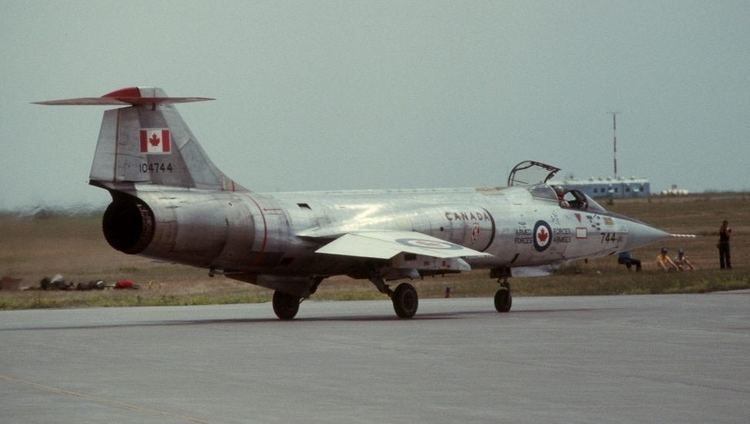 | ||
Unit cost 2,000,000–2,000,000 CAD (1969) Similar Republic F 105 Thunderchief, McDonnell Douglas F 4 Phantom II, Lockheed F 104 Starfighter | ||
The Canadair CF-104 Starfighter (CF-111, CL-90) was a modified version of the Lockheed F-104 Starfighter supersonic fighter aircraft built in Canada by Canadair under licence. It was primarily used as a ground attack aircraft, despite being designed as an interceptor. It served with the Royal Canadian Air Force (RCAF) and later the Canadian Armed Forces (CAF) until it was replaced by the McDonnell Douglas CF-18 Hornet.
Contents
- Design and development
- Operational history
- AFCENT Tactical Weapons Meet strike era
- AFCENT Tactical Weapons Meet attack era
- Royal Flush
- Tiger Meet
- Variants
- Operators
- Accidents and incidents
- Aircraft on display
- Survivors
- Specifications CF 104
- References
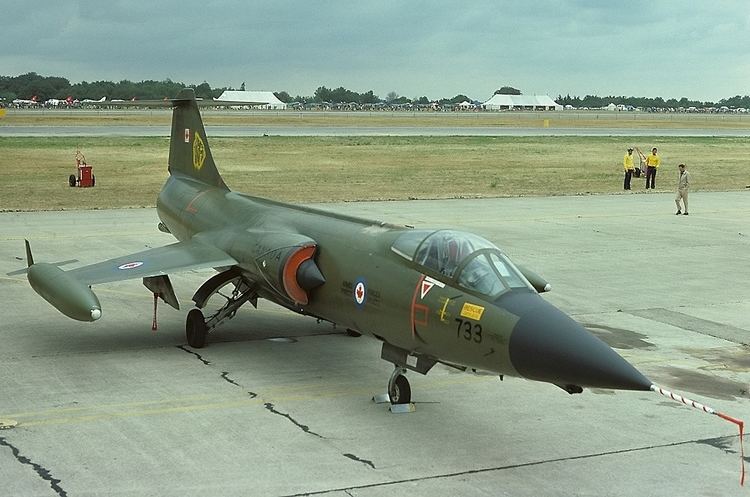
Design and development
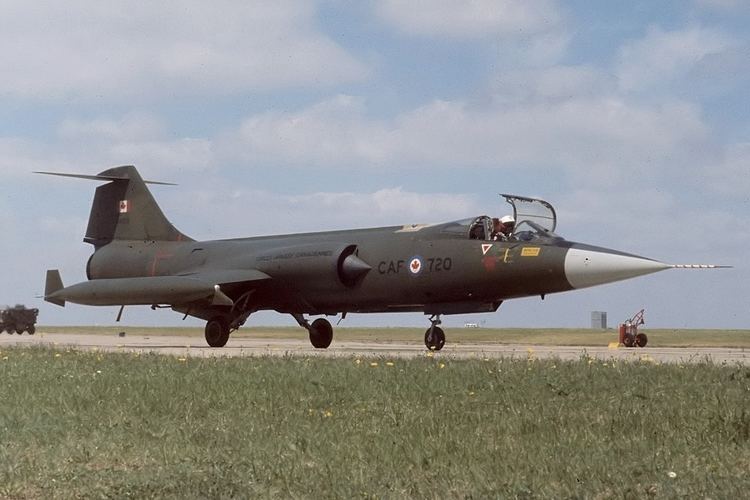
In the late 1950s, Canada redefined its role in the North Atlantic Treaty Organization (NATO) with a commitment to a nuclear strike mission. At the same time, the RCAF began to consider a replacement for the Canadair F-86 Sabre series that had been utilized as a NATO day fighter. An international fighter competition involved current types in service as well as development, including the Blackburn Buccaneer, Dassault Mirage IIIC, Fiat G.91, Grumman Super Tiger, Lockheed F-104G Starfighter, Northrop N-156 and the Republic F-105 Thunderchief. Although the RCAF had preferred the F-105 Thunderchief equipped with an Avro Canada Orenda Iroquois engine, eventually the choice for a strike-reconnaissance aircraft revolved around cost as well as capability.
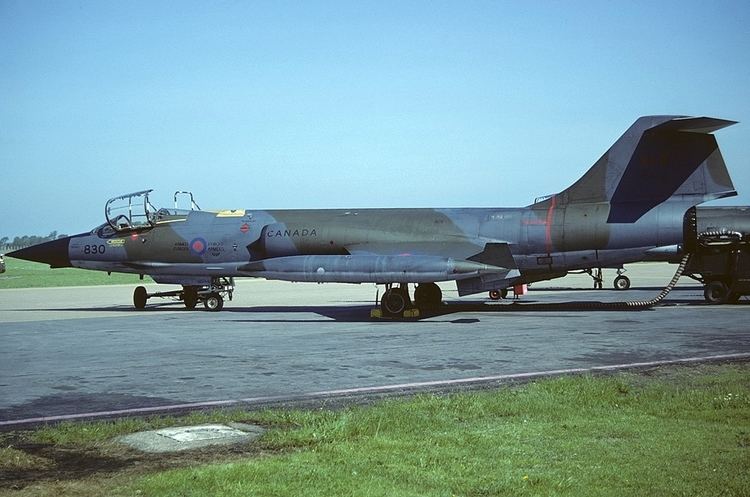
A Canadian government requirement for a license manufacture also favoured the Lockheed proposal due to a collaboration with Canadair based in Montreal. On 14 August 1959, Canadair was selected to manufacture 200 aircraft for the RCAF under license from Lockheed. In addition, Canadair was contracted to manufacture wingsets, tail assemblies and rear fuselage sections for 66 Lockheed-built F-104Gs destined for the West German Luftwaffe.
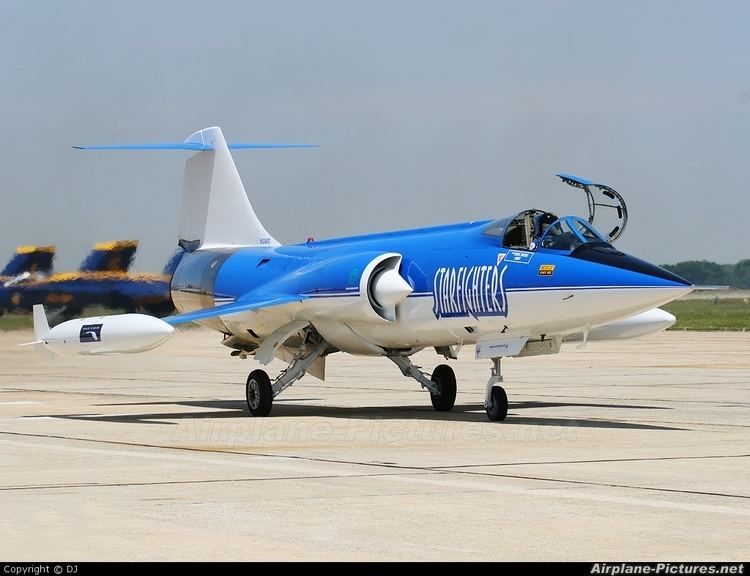
Canadair's internal designation was CL-90 while the RCAF's version was initially designated CF-111, then changed to CF-104. Although basically similar to the F-104G, the CF-104 was optimized for the nuclear strike/reconnaissance role, fitted with R-24A NASARR equipment dedicated to the air-to-ground mode only as well as having provision for a ventral reconnaissance pod equipped with four Vinten cameras. Other differences included retaining the removable refuelling probe, initial deletion of the fuselage-mounted 20 mm (.79 in) M61A1 cannon (replaced by an additional fuel cell) and the main undercarriage members being fitted with longer-stroke liquid springs and larger tires. The first flight of a Canadian-built CF-104 (s/n 12701) occurred on 26 May 1961. The Canadair CF-104 production was 200 aircraft with an additional 140 F-104Gs produced for Lockheed.
Operational history
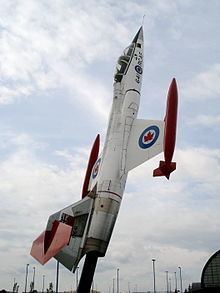
The CF-104 entered Canadian service in March 1962. Originally designed as a supersonic interceptor aircraft, it was used primarily for low-level strike and reconnaissance by the RCAF. Eight CF-104 squadrons were originally stationed in Europe as part of Canada's NATO commitment. This was reduced to six in 1967, with a further reduction to three squadrons in 1970. Up to 1971, this included a nuclear strike role that would see Canadian aircraft armed with US-supplied nuclear weapons in the event of a conflict with Warsaw Pact forces. During its service life the CF-104 carried the B28, B43 and B57 nuclear weapons.
When the CAF later discontinued the strike/reconnaissance role for conventional attack, the M61A1 was refitted, along with U.S. Snakeye "iron" bombs, British BL755 cluster bombs and Canadian-designed CRV-7 rocket pods. Although Canadian pilots practised air combat tactics, AIM-9 Sidewinder missiles were never carried operationally by Canadian Starfighters (however, examples provided to other air forces, such as Norway and Denmark, did carry Sidewinders on a twin-rail centreline station and the wingtip rails). The CF-104D two-seater did not normally carry any armament except for a centreline practice-bomb dispenser.
There were 110 class A accidents in the 25 years that Canada operated the CF-104 resulting in 37 pilot fatalities. Most of these were in the early part of the program centering on teething problems. Of the 110 class A accidents 21 were attributed to foreign object damage (14 of which were birds), 14 were in flight engine failures, 6 were faulty maintenance, 9 were mid air collisions. 32 struck the ground flying at low level in poor weather conditions. Of the 37 fatalities 4 were clearly attributable to systems failures, all of the others were attributable to some form of pilot inattention.
The accident rate of the 104 compares favourably to its predecessor, the F-86 Sabre. In only 12 years of operation the F-86 had 282 class A accidents with a loss of 112 pilots. The Sabre was also a simpler aircraft and was flown at altitude.
The CF-104 was nicknamed the "Widowmaker" by the press but not by the pilots and crews of the aircraft. David Bashow states on page 92 of his book "I never heard a pilot call it the Widowmaker". Sam Firth is quoted on page 93 in Bashow's book "I have never heard a single person who flew, maintained, controlled, or guarded that aircraft of any force (and that includes the Luftwaffe) call it the Widowmaker". The pilots did refer to it, in jest, as the "Aluminium Death Tube", "The Lawn Dart" and "The Flying Phallus" but generally called it the 104 (one oh four) or the Starfighter.
Low level attack runs in the 104 were done visually at 100 feet AGL and at speeds up to 600 kn. Low level evasive maneuvers could increase speeds to supersonic.
The 104 was very difficult to attack owing to its small size, speed, and low altitude capability. Dave Jurkowski, former CF-104 and CF-18 pilot is quoted "Because of our speed, size and lower level operations, no Canadian Zipper driver was ever 'shot down' by either air or ground threats in the three Red Flag Exercises in which we participated."
The CF-104 was very successful in operational exercises held by NATO. The Canadians first took part in the AFCENT Tactical Weapons meet in 1964 and did so every year after that. This meet was a competition between squadrons from Belgium, France, Germany, USA, Britain, and the Netherlands. Scores were based on several factors. Bomb accuracy, time on target, navigation, mission planning and aircraft serviceability. Pilots were chosen at random from the various squadrons to accurately represent operational capabilities.
AFCENT Tactical Weapons Meet (strike era)
AFCENT Tactical Weapons Meet (attack era)
biennial schedule.
Royal Flush
A competition for Recce squadrons. The Canadians first took part in 1966 and managed the following awards:
Tiger Meet
A competition between NATO squadrons with cat mascots.
In the late 1970s, the New Fighter Aircraft program was launched to find a suitable replacement for the CF-104, as well as the McDonnell CF-101 Voodoo and the Canadair CF-5. The winner of the competition was the CF-18 Hornet, which began to replace the CF-104 in 1982. All of the CF-104s were retired from service by the Canadian Forces by 1987, with most of the remaining aircraft given to Turkey.
Variants
Operators
Accidents and incidents
Aircraft on display
Survivors
Specifications (CF-104)
General characteristics
Performance
Armament
